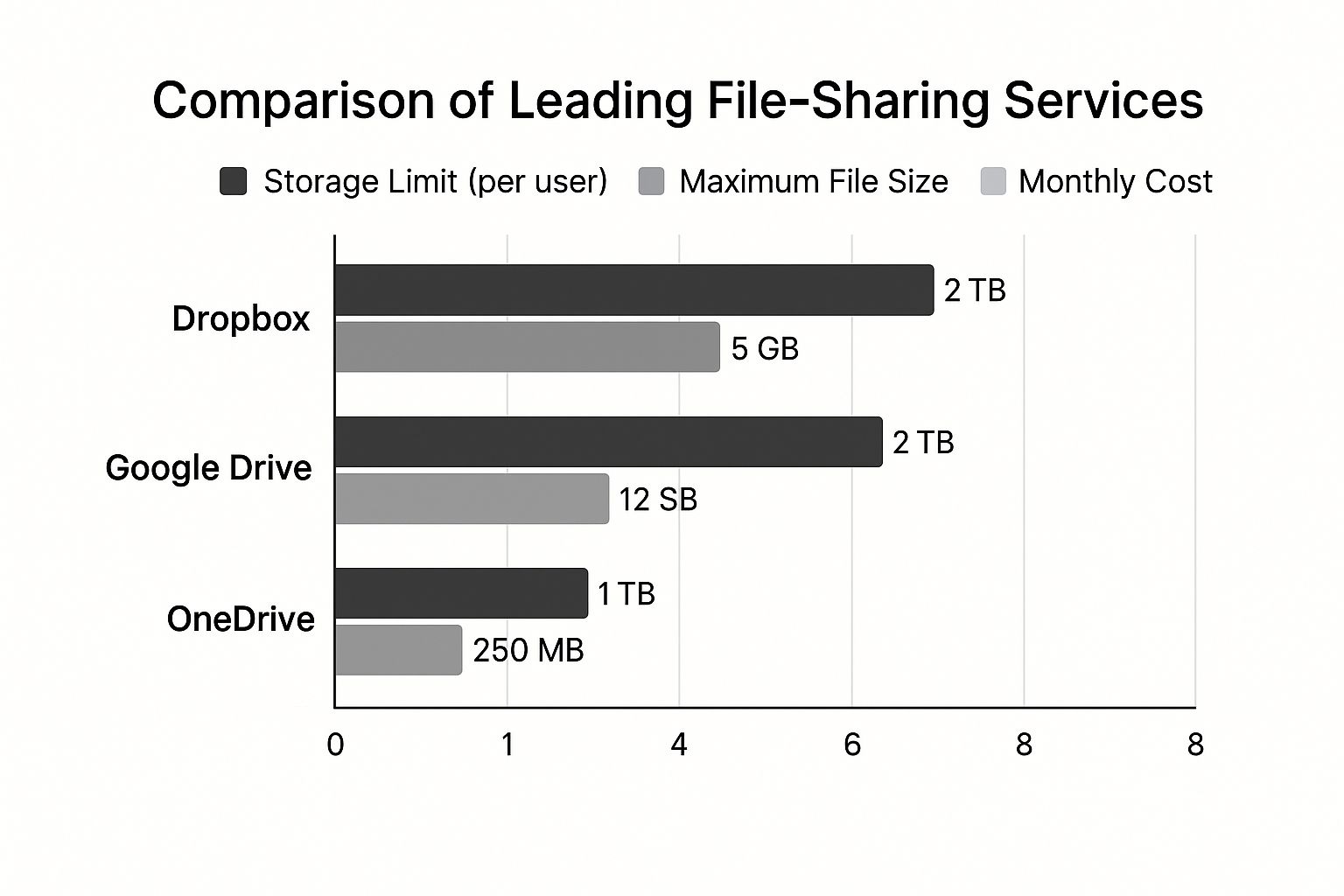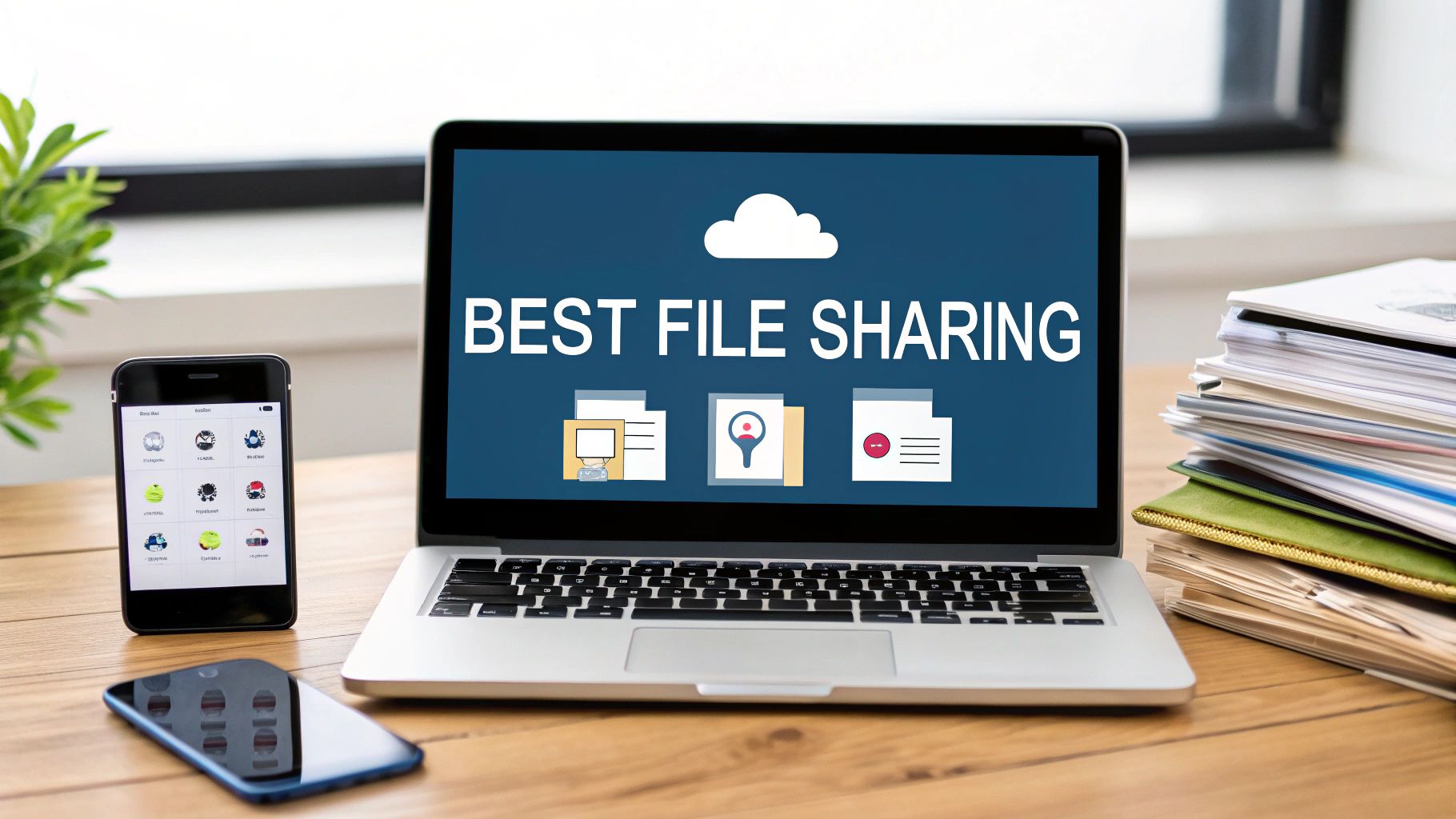When it comes to finding the best file sharing for business, I've learned you have to look past the free, consumer-grade tools we all know and use. While they're fine for personal stuff, using a standard cloud account for professional work is a recipe for disaster. From my experience, they just don't have the security, control, or compliance features you need, and that creates some serious hidden risks.
Why Generic File Sharing Fails Your Business

Ever used your personal cloud drive to quickly send a work file? I think we've all been there. It feels fast and simple, but it’s a bit like trying to move office furniture with a bicycle. Sure, it might work for a small chair, but it's a terrible and risky idea for anything important.
Using these personal tools for professional work is just asking for trouble. Security is the most glaring issue. Consumer platforms are a magnet for cyberattacks, and a single breach could expose sensitive client information or confidential company documents.
On top of that, they create total chaos for team collaboration. Without proper version control, people quickly lose track of which file is the most recent. This leads to wasted hours and costly mistakes. I've seen it happen: multiple people editing a critical client proposal, only to find out the final version sent to the client was three drafts old.
The Necessity of a Business-Grade Solution
This is exactly why a dedicated business file-sharing solution isn't a luxury—it's an absolute necessity. These platforms are built from the ground up with professional needs in mind from day one.
They deliver critical features that consumer-grade services simply can't match:
- Advanced Encryption: Your data is protected both in transit and at rest.
- Granular User Permissions: You get to control exactly who can view, edit, or download specific files and folders. No more, no less.
- Comprehensive Audit Trails: A detailed log shows every single action taken on a file, which is crucial for accountability and compliance.
The demand for these robust tools is driving massive growth. The global Enterprise File Synchronization and Sharing (EFSS) market was valued at USD 11.49 billion in 2024 and is expected to skyrocket to USD 122.96 billion by 2035. This explosive growth shows just how seriously businesses are taking data security and workflow efficiency. You can dig deeper into the trends driving the enterprise file sharing market on SphericalInsights.com.
Ultimately, picking the right tool isn't just about where you store your files. It’s about building a secure, scalable foundation for your entire operation.
Defining Your Evaluation Criteria
Choosing the right file-sharing service for your business goes way beyond just looking at who offers the most gigabytes. If you want to make a smart call, you need a solid checklist. Let's cut through the marketing fluff and get down to what actually matters for your day-to-day operations.
First up, and it's a big one: security. I'm not just talking about passwords. We need to look at deep, protocol-level protection. You have to know if the service uses strong encryption for your files while they're being sent (in transit) and while they're sitting on a server (at rest). Anything less is a deal-breaker.
Security and Compliance Standards
As you map out your security needs, think about how a platform helps with your overall compliance. Things like robust security validated by automated penetration testing for SOC 2 compliance are a huge green flag. Platforms should be totally transparent about how they protect your data.
We take this stuff very seriously at HeftySend. You can see our entire approach to data protection laid out in our HeftySend privacy policy to get a clear picture of how we handle your information.
Next on the list are compliance certifications. If you're in a regulated field like healthcare (HIPAA) or deal with data from European citizens (GDPR), your file-sharing service absolutely must meet those legal standards. Getting this wrong can lead to massive fines and a serious blow to your reputation.
A service's compliance isn't just a fancy badge for their website; it's a core feature that shields your business from very real legal and financial heat.
Core Functionality and User Experience
Once you've got security nailed down, it's time to look at the core functions. How well does the platform actually play with the software you already use every day, like your project management tool or CRM? Smooth integrations mean less friction and more productivity.
You'll also want to look for a few key features that keep everyone accountable:
- Version History: Can you easily track changes and roll back to an older version of a file? This is a lifesaver for avoiding costly mistakes, especially when multiple people are collaborating.
- Detailed Activity Logs: You need a clear audit trail. It should show you exactly who accessed, downloaded, or shared a file and when they did it. For data governance, this is non-negotiable.
The demand for these kinds of secure, business-first features is precisely why the enterprise file-sharing market is taking off. The market was valued at USD 14.9 billion in 2025 and is projected to skyrocket to USD 145.5 billion by 2035. This explosive growth shows just how quickly businesses are moving away from old, insecure methods. You can learn more about the growth of the EFSS market at Research Nester.
How Industry Leaders Compare
When you start digging into business file sharing, you’ll see the same three names over and over: Google Drive, Dropbox Business, and Microsoft OneDrive. They're the giants for a reason, but they are absolutely not interchangeable. Let's get real about how they actually stack up, beyond the marketing fluff.
Choosing between them often boils down to one simple question: what ecosystem does your business already live in? If your team is deep into Microsoft 365—running on Teams, Outlook, and Office all day—then OneDrive is the no-brainer. Its native integration creates a truly seamless workflow that’s just tough to beat.
But for a fast-moving creative agency that thrives on collaboration, Google Drive’s real-time editing is a godsend. The ability for multiple people to jump into a single document and work simultaneously is a total game-changer for brainstorming and hammering out quick revisions.
A Closer Look at Dropbox Business
And then there's Dropbox Business. It might not have the sprawling software suite of a Google or Microsoft, but its power is in its focused simplicity and clean user experience. For years, it's been the go-to for professionals who just need a dead-simple, reliable tool that works. Every time.
Here's a peek at the clean interface that has kept Dropbox a favorite among professional teams for years.

The entire platform is built around making file sync and sharing as intuitive as possible, which means less time training new team members and more time getting work done.
These platforms are all fighting for a piece of a massive pie. The global market for this stuff hit USD 9.4 billion in 2023 and is on track to explode to USD 35.5 billion by 2028. If you're a data nerd, you can get the full breakdown on this massive market growth at MarketsandMarkets.
Unpacking The Key Differences
To make sense of it all, let’s put them side-by-side.
Feature Comparison of Leading Business File Sharing Platforms
Here’s a quick-glance comparison of the key features, security, and pricing structures for the most popular business file sharing solutions. This table helps cut through the noise to see how they truly stack up.
| Feature | Google Drive | Dropbox Business | Microsoft OneDrive | HeftySend |
|---|---|---|---|---|
| Best For | Real-time collaboration | Simplicity & reliability | Microsoft 365 integration | External large file transfers |
| Storage | 2 TB - 5 TB per user | Starts at 9 TB total | 1 TB - Unlimited per user | Unlimited (BYO Storage) |
| Max File Size | 5 TB | 2 TB (web), 250 GB (app) | 250 GB | No Limit (BYO Storage) |
| Security | 2FA, data encryption | 2FA, 256-bit AES | 2FA, BitLocker encryption | 2FA, end-to-end encryption |
| Unique Feature | Google Docs/Sheets/Slides | Dropbox Paper, Smart Sync | Deep Office 365 integration | Full data ownership (BYOS) |
| Pricing | Starts at $12/user/month | Starts at $15/user/month | Included with Microsoft 365 | Starts at $12/month (flat) |
While this gives a good overview, the real differences emerge in how your team actually works day-to-day.
Collaboration Style vs. Ecosystem Fit
Ecosystem Integration: For any business running on Microsoft, OneDrive is king. It’s not even a competition. Google Drive is the obvious choice for teams embedded in Google Workspace. Dropbox, on the other hand, is the Switzerland of file sharing—it plays nice with almost everything but doesn't own the whole stack.
Collaboration Style: Google Drive is built for live, simultaneous document editing. Nothing beats it for that use case. OneDrive's collaboration is more tightly woven into the desktop Office apps, which some people absolutely prefer. Dropbox has strong tools like annotations and Dropbox Paper, but they feel a bit separate from the core file-sharing experience.
The decision isn't about which service is objectively "best," but which one aligns most closely with your team's existing habits and technical infrastructure. A poor fit, no matter how powerful the tool, will always lead to friction.
At the end of the day, these platforms are designed to be all-in-one solutions for internal team storage and collaboration. They are incredibly powerful, but that power comes with complexity. For businesses that mainly need a streamlined way to send large, secure files externally, a more specialized tool might be a much better fit.
A Focused Solution for Secure File Transfers
The big names in file sharing do a great job with their all-in-one suites for internal teams. But let's be honest—sometimes, it feels like using a sledgehammer to crack a nut. If your main goal is just sending large, sensitive files to people outside your organization, all that complexity just gets in the way.
This is exactly where a specialized tool shines. It’s built for businesses that don’t need a massive collaboration ecosystem but absolutely demand a rock-solid, simple way to transfer critical files. It's the very problem we built HeftySend to solve, and we're really proud of it.
When Simplicity Equals Strength
Picture this: you're a video editor sending a final cut to a client, a law firm delivering confidential case files, or an architect sharing massive project blueprints. Your primary need isn't a shared digital workspace; it's a secure, direct line for that delivery with proof it arrived safely.
A focused tool strips away the extra features to perfect the core job of transferring files. Here’s what that actually looks like:
- Password-Protected Transfers: You can slap a password on any link, ensuring only the right person can open it.
- Link Expiration Dates: Set your links to die automatically after a specific time or number of downloads. This prevents indefinite access to sensitive data.
- Real-Time Download Tracking: Get instant notifications and clear logs showing who downloaded your files and when. It’s an essential audit trail for client work.
We designed HeftySend’s clean interface to make these crucial security features intuitive and fast, without getting lost in confusing menus.

This is what it looks like in practice. HeftySend puts the most important transfer options right at your fingertips, making a secure send a one-step process.
Why Specialization Matters for Security
General-purpose platforms are built to manage ongoing access for internal teams. Specialized transfer tools, on the other hand, are built around the security model of a single, secure transaction. When looking for a solution, it's smart to understand how providers tackle security, which is often detailed in a comprehensive threat and vulnerability management guide. With a specialized tool, security isn't just one feature among many—it's the entire point.
For external deliverables, the goal is controlled, temporary access, not permanent collaboration. A dedicated transfer tool is built around this principle, reducing your data exposure by design.
It's a different way of thinking about the best file sharing for business. While platforms like Google Drive and OneDrive are great at creating a digital office for your team, we built HeftySend to be more like a trusted courier service for your most important digital packages. You can learn more about how we approach secure https://heftysend.com/file-sharing and see why our focused approach might be the perfect fit for your workflow. It's all about getting the right tool for the job.
Choosing the Right Tool for Your Use Case

Here's the truth I've come to realize: there's no single "best" file-sharing service. The right choice hinges entirely on how you work, who you're sharing with, and what you’re sending. Let’s look at a few real-world scenarios to see which tools actually fit certain jobs.
Take a busy creative agency. Their entire workflow is built on sharing massive video files, high-res photos, and design mockups for client feedback. Speed is everything, but so are review tools. A platform that lets a client drop a comment on a specific frame of a video is a game-changer. For them, Dropbox Business is a natural fit, given its strong focus on the creative industry and its solid preview features.
Matching Solutions to Specific Needs
Now, picture a law firm. They’re dealing with highly sensitive client documents, contracts, and case files. The priorities here are completely different. Iron-clad security, detailed audit trails, and strict compliance with privacy regulations are non-negotiable. One misplaced email attachment could have serious legal repercussions.
This team needs a service with granular permissions and detailed activity logs. Microsoft OneDrive, especially when tied into the broader Microsoft 365 security ecosystem, is often the answer. The ability to control who can view, print, or download a file is absolutely critical.
The most important question isn't "Which platform has the most features?" but "Which platform has the features that solve my biggest daily problem?"
You have to be honest about your primary workflow. Are you constantly collaborating on live documents with your internal team, or is your main headache sending large, finished files to people outside your company? The answer changes everything.
The Clear Choice for External File Transfers
If your business is all about sending large, final deliverables—think project files, video exports, or client reports—your needs are different from a team that lives inside shared documents. You just need something that's fast, secure, and dead simple for the person on the other end.
This is the sweet spot for a specialized service like HeftySend. We built it specifically for that "send and track" workflow, skipping the complexity of a full collaboration suite. You can password-protect a massive file, set it to expire, and get a notification the second your client downloads it. It solves one problem perfectly, which is often far better than a tool that tries to solve every problem at once.
Our straightforward plans are designed for this exact purpose. You can explore the different HeftySend pricing options to see how it aligns with your transfer needs.
Making Your Final Decision
So, after looking at all the options, how do you actually choose? The truth is, the best file sharing for business isn't a single platform. It’s about picking the right tool for the job you need to get done.
If your team is already living and breathing in the Microsoft or Google ecosystems, sticking with OneDrive or Google Drive is a no-brainer. Their integrations are just too good to ignore for day-to-day work inside your company. They are fantastic suites for keeping internal teams on the same page.
Finding Your Perfect Fit
But what about when you need to send large, sensitive files to people outside your company? For clients, partners, or vendors, a specialized tool is almost always the smarter way to go. This is where you need something built specifically for secure external delivery, not just internal chatter.
This is exactly where HeftySend shines, and I genuinely believe it's the clear winner for this specific task. It skips all the extra features you don’t need and focuses on one thing: making sure your files get there fast, securely, and without any fuss. It’s built to solve that one problem perfectly.
Instead of getting lost in a sea of features you'll never use, a focused tool ensures your most important deliveries are handled with the security and simplicity they deserve.
Don't just take my word for it—see the difference yourself. You can start a free trial at HeftySend.com right now and see how quickly it can improve the way you send those crucial external files.
Common Questions Answered
When you're trying to find the right file-sharing service for your business, a few key questions always come up. Let's dig into the answers to help you get clear on what really matters.
What's the Most Secure Way to Share Business Files?
The best security isn't a single feature—it's a layered approach. You absolutely need end-to-end encryption, which keeps your data scrambled and unreadable from the moment it leaves your computer until your recipient opens it. Beyond that, essentials like password protection, expiring links, and two-factor authentication (2FA) are non-negotiable.
On the technical side, look for protocols like SFTP (SSH File Transfer Protocol) or FTPS (File Transfer Protocol over SSL/TLS). They're the gold standard. SFTP often gets the nod for being easier on firewalls since it uses just one port (port 22) for everything, which can make life a lot simpler for your IT team.
Can I Just Use a Free Service for My Business?
It’s tempting, but honestly, it’s a bad idea. Free, consumer-focused platforms just don't have the security, audit trails, or compliance certifications (think HIPAA or GDPR) that a business needs to stay safe. One data leak can cost you dearly in fines and lost trust. A dedicated business solution isn't an expense; it's an investment in your company's security and reputation.
All-In-One Suite or a Specialized Tool?
This really boils down to what you're trying to accomplish.
If your day-to-day is all about internal teams working together on documents, a big all-in-one suite like Google Drive or OneDrive makes a lot of sense. They're built from the ground up to be a shared digital workspace.
But if your main headache is getting large, sensitive files to clients and partners outside your organization, a specialized tool is the way to go. Services like HeftySend are laser-focused on making that one process as secure and painless as possible. They cut out the collaboration clutter to perfect the transfer itself, with critical features like download tracking and robust security front and center.
Ready to stop worrying about file transfers and start sending with confidence? We created HeftySend to offer a simple, secure, and powerful way to deliver your most important files.
